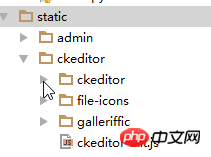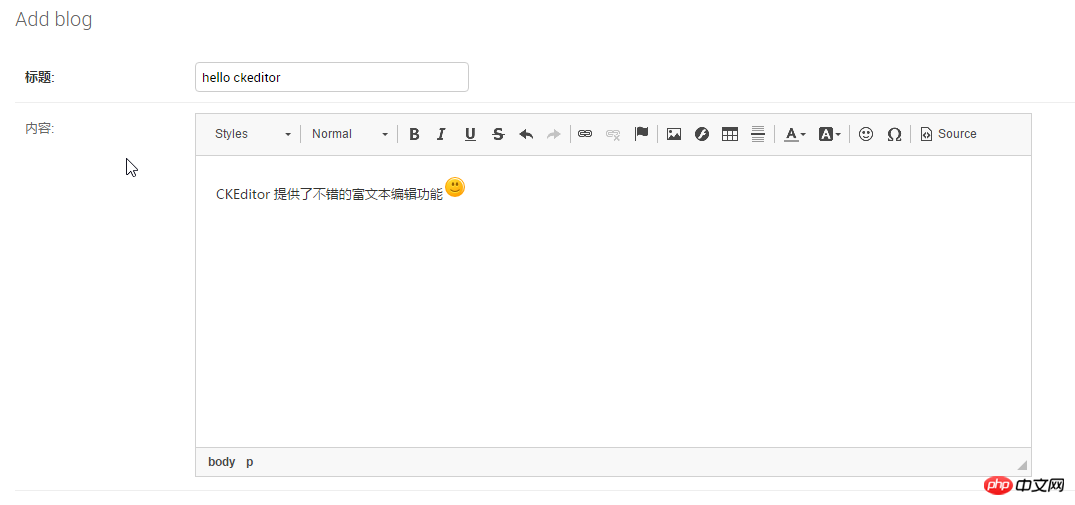 Backend Development
Backend Development
 Python Tutorial
Python Tutorial
 Django teaches you how to master the rich text editor CKEditor
Django teaches you how to master the rich text editor CKEditor
Django teaches you how to master the rich text editor CKEditor
Recently, I need to use rich text in django adminEditor. Since I prefer CKEditor rich text editor, I have this article. The following article mainly introduces it to you. Friends in need can refer to how to easily use the rich text editor CKEditor in Django.
Preface
Django is an easy and quick web framework, use it to create content driven type websites (such as independent blogs) are very convenient. Unfortunately, Django does not provide an official rich text editor, which happens to be an indispensable control in the backend management of content-based websites. ckeditor is a widely used open source web page editor based on javascript. It can be combined with a variety of programming languages, and python is of course no exception. This article will introduce how to use ckeditor perfectly in a Django-based blog system.
Usage
1. Install
pip install django-ckeditor
2. Change INSTALLED_APPS## in 'ckeditor'settings.py
#3. Since djang-ckeditor uses JQuery in the ckeditor-init.js file, you need to set CKEDITOR_JQUERY_URL in settings.py to specify the path of the JQuery library, for example:CKEDITOR_JQUERY_URL ='https://apps.bdimg.com/libs/jquery/2.1.4/jquery.min.js'
python manage.py collectstatic, and copy the media resources required by CKEditor into the path specified by STATIC_ROOT.
STATIC_ROOT = os.path.join(BASE_DIR,'static/')

from django.db import models from ckeditor.fields import RichTextField class Blog(models.Model): title = models.CharField(max_length=50,verbose_name="标题") content = RichTextField(blank=True,null=True,verbose_name="内容") def unicode(self): return self.name

##File upload 1. Add ckeditor_uploader in INSTALLED_APPS in settings.py
2. CKEditor uses Django’s storage
API, and uses Django’s files by default For storage, MEDIA_ROOT and MEDIA_URL will be used, which need to be defined in settings.py. In addition, CKEDITOR_UPLOAD_PATH can also be specified, which is located under MEDIA_ROOT: MEDIA_URL = '/media/'
MEDIA_ROOT = os.path.join(BASE_DIR,'media/')
CKEDITOR_UPLOAD_PATH = 'uploads/'
url(r'^ckeditor/', include('ckeditor_uploader.urls')),
If not added, the following error may occur:
 4. (Optional) Add CKEDITOR_IMAGE_BACK
4. (Optional) Add CKEDITOR_IMAGE_BACK
CKEDITOR_IMAGE_BACKEND = 'PIL'
from ckeditor_uploader.fields import RichTextUploadingField class Post(models.Model): content = RichTextUploadingField()
The above is the detailed content of Django teaches you how to master the rich text editor CKEditor. For more information, please follow other related articles on the PHP Chinese website!

Hot AI Tools

Undresser.AI Undress
AI-powered app for creating realistic nude photos

AI Clothes Remover
Online AI tool for removing clothes from photos.

Undress AI Tool
Undress images for free

Clothoff.io
AI clothes remover

Video Face Swap
Swap faces in any video effortlessly with our completely free AI face swap tool!

Hot Article

Hot Tools

Notepad++7.3.1
Easy-to-use and free code editor

SublimeText3 Chinese version
Chinese version, very easy to use

Zend Studio 13.0.1
Powerful PHP integrated development environment

Dreamweaver CS6
Visual web development tools

SublimeText3 Mac version
God-level code editing software (SublimeText3)

Hot Topics
 How to check django version
Dec 01, 2023 pm 02:25 PM
How to check django version
Dec 01, 2023 pm 02:25 PM
Steps to check the Django version: 1. Open a terminal or command prompt window; 2. Make sure Django has been installed. If Django is not installed, you can use the package management tool to install it and enter the pip install django command; 3. After the installation is complete , you can use python -m django --version to check the Django version.
 Django vs. Flask: A comparative analysis of Python web frameworks
Jan 19, 2024 am 08:36 AM
Django vs. Flask: A comparative analysis of Python web frameworks
Jan 19, 2024 am 08:36 AM
Django and Flask are both leaders in Python Web frameworks, and they both have their own advantages and applicable scenarios. This article will conduct a comparative analysis of these two frameworks and provide specific code examples. Development Introduction Django is a full-featured Web framework, its main purpose is to quickly develop complex Web applications. Django provides many built-in functions, such as ORM (Object Relational Mapping), forms, authentication, management backend, etc. These features allow Django to handle large
 Django Framework Pros and Cons: Everything You Need to Know
Jan 19, 2024 am 09:09 AM
Django Framework Pros and Cons: Everything You Need to Know
Jan 19, 2024 am 09:09 AM
Django is a complete development framework that covers all aspects of the web development life cycle. Currently, this framework is one of the most popular web frameworks worldwide. If you plan to use Django to build your own web applications, then you need to understand the advantages and disadvantages of the Django framework. Here's everything you need to know, including specific code examples. Django advantages: 1. Rapid development-Djang can quickly develop web applications. It provides a rich library and internal
 How to upgrade Django version: steps and considerations
Jan 19, 2024 am 10:16 AM
How to upgrade Django version: steps and considerations
Jan 19, 2024 am 10:16 AM
How to upgrade Django version: steps and considerations, specific code examples required Introduction: Django is a powerful Python Web framework that is continuously updated and upgraded to provide better performance and more features. However, for developers using older versions of Django, upgrading Django may face some challenges. This article will introduce the steps and precautions on how to upgrade the Django version, and provide specific code examples. 1. Back up project files before upgrading Djan
 What text editors are there for java?
Oct 16, 2023 am 11:14 AM
What text editors are there for java?
Oct 16, 2023 am 11:14 AM
Java text editors include Eclipse, IntelliJ IDEA, NetBeans, Visual Studio Code, Sublime Text, Atom, jEdit, BlueJ, Code::Blocks, Notepad++, etc.
 Is django front-end or back-end?
Nov 21, 2023 pm 02:36 PM
Is django front-end or back-end?
Nov 21, 2023 pm 02:36 PM
django is the backend. Details: Although Django is primarily a backend framework, it is closely related to front-end development. Through features such as Django's template engine, static file management, and RESTful API, front-end developers can collaborate with back-end developers to build powerful, scalable web applications.
 What is the difference between django versions?
Nov 20, 2023 pm 04:33 PM
What is the difference between django versions?
Nov 20, 2023 pm 04:33 PM
The differences are: 1. Django 1.x series: This is an early version of Django, including versions 1.0, 1.1, 1.2, 1.3, 1.4, 1.5, 1.6, 1.7, 1.8 and 1.9. These versions mainly provide basic web development functions; 2. Django 2.x series: This is the mid-term version of Django, including 2.0, 2.1, 2.2 and other versions; 3. Django 3.x series: This is the latest version series of Django. Including versions 3.0, 3, etc.
 How to check django version
Nov 30, 2023 pm 03:08 PM
How to check django version
Nov 30, 2023 pm 03:08 PM
How to check the django version: 1. To check through the command line, enter the "python -m django --version" command in the terminal or command line window; 2. To check in the Python interactive environment, enter "import django print(django. get_version())" code; 3. Check the settings file of the Django project and find a list named INSTALLED_APPS, which contains installed application information.





